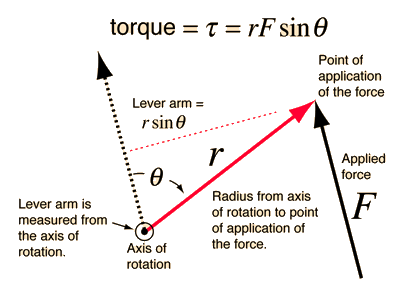Torque calculation part 2
When a force of 6.0 N is exerted at to a wrench at a distance of 8 cm from the nut, it is just able to loosen the nut. What force would be sufficient to loosen it, if it acts perpendicularly to the wrench at 16 cm from the nut?
This section requires Javascript.
You are seeing this because something didn't load right. We suggest you, (a) try
refreshing the page, (b) enabling javascript if it is disabled on your browser and,
finally, (c)
loading the
non-javascript version of this page
. We're sorry about the hassle.
Torque can be calculated using the formula: T = rFsin(x). Image Source Hyperphysics
Image Source Hyperphysics
Where T = Torque, r = distance from nut, F is magnitude of force applied to nut, and sin(x) is the angle of the axis of orientation to the nut by the lever or wrench.
So, given: F = 6 N, angle = 30 degrees, and r = 8 cm: T = 8 cm * 6.0 N * sin(30) T = 23.99 N. Which is equal to approximately 24 N
If the angle of the axis of orientation is perpendicular, then sin(x) will be sin(90) - maximum torque. So, given: angle = 90 degrees, r = 16 cm. It can be assumed that the force required to move the nut will be less than 6 N.
Plugging in: T = 16 cm *1.5 N * sin(90) T = 24 N. Therefore: 1.5 N is a sufficient force to move the nut when the angle is 90 degrees and r is 16 cm from the nut.